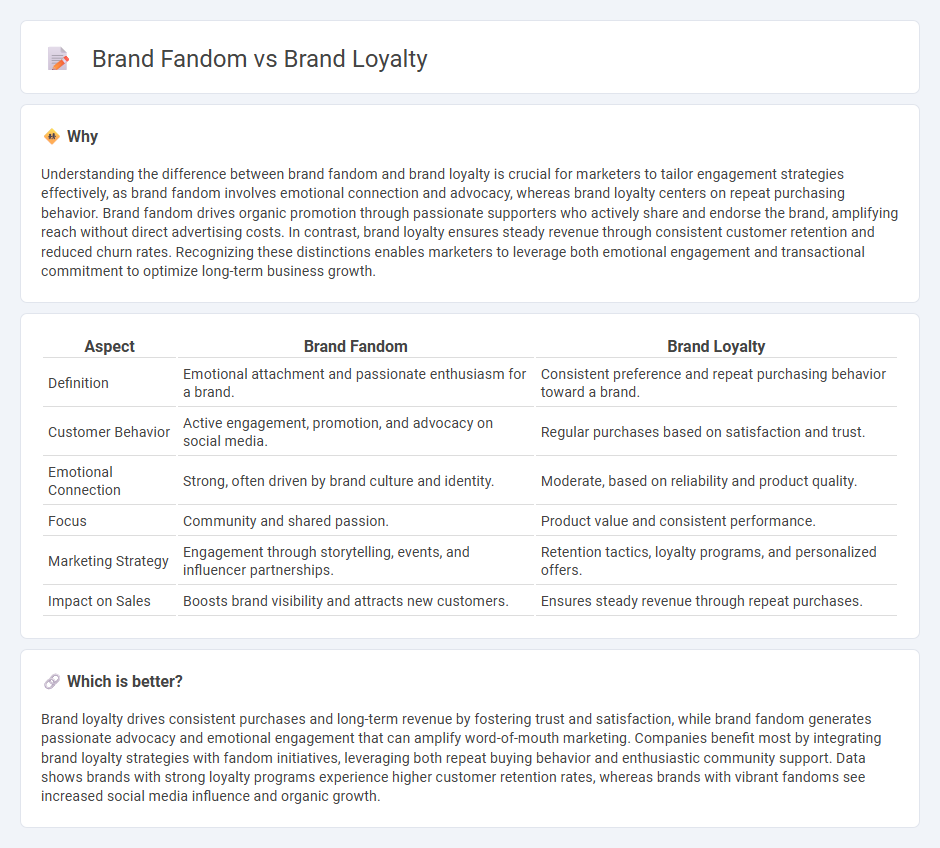
Brand fandom involves passionate and emotional engagement with a brand, often driven by community and identity, while brand loyalty focuses on consistent, repeated purchasing behavior based on satisfaction and trust. Fans actively promote and defend brands, creating organic word-of-mouth marketing, whereas loyal customers ensure steady revenue through their continued patronage. Explore deeper insights into how these concepts influence consumer behavior and marketing strategies.
Why it is important
Understanding the difference between brand fandom and brand loyalty is crucial for marketers to tailor engagement strategies effectively, as brand fandom involves emotional connection and advocacy, whereas brand loyalty centers on repeat purchasing behavior. Brand fandom drives organic promotion through passionate supporters who actively share and endorse the brand, amplifying reach without direct advertising costs. In contrast, brand loyalty ensures steady revenue through consistent customer retention and reduced churn rates. Recognizing these distinctions enables marketers to leverage both emotional engagement and transactional commitment to optimize long-term business growth.
Comparison Table
| Aspect | Brand Fandom | Brand Loyalty |
|---|---|---|
| Definition | Emotional attachment and passionate enthusiasm for a brand. | Consistent preference and repeat purchasing behavior toward a brand. |
| Customer Behavior | Active engagement, promotion, and advocacy on social media. | Regular purchases based on satisfaction and trust. |
| Emotional Connection | Strong, often driven by brand culture and identity. | Moderate, based on reliability and product quality. |
| Focus | Community and shared passion. | Product value and consistent performance. |
| Marketing Strategy | Engagement through storytelling, events, and influencer partnerships. | Retention tactics, loyalty programs, and personalized offers. |
| Impact on Sales | Boosts brand visibility and attracts new customers. | Ensures steady revenue through repeat purchases. |
Which is better?
Brand loyalty drives consistent purchases and long-term revenue by fostering trust and satisfaction, while brand fandom generates passionate advocacy and emotional engagement that can amplify word-of-mouth marketing. Companies benefit most by integrating brand loyalty strategies with fandom initiatives, leveraging both repeat buying behavior and enthusiastic community support. Data shows brands with strong loyalty programs experience higher customer retention rates, whereas brands with vibrant fandoms see increased social media influence and organic growth.
Connection
Brand fandom and brand loyalty are interconnected through emotional attachment and consistent positive experiences that foster strong consumer-brand relationships. Fans of a brand often exhibit higher repeat purchase rates and advocacy behaviors, driving sustained brand loyalty over time. This synergy enhances customer lifetime value and amplifies brand equity in competitive markets.
Key Terms
Customer Retention
Brand loyalty reflects consistent repeat purchases driven by satisfaction and trust, whereas brand fandom involves emotional engagement and active promotion of the brand. Customer retention strategies should leverage loyalty by enhancing product satisfaction and trust, while brand fandom can be cultivated through community building and exclusive brand experiences. Explore advanced tactics to balance both approaches for optimal customer retention.
Emotional Engagement
Brand loyalty involves consistent repeat purchases driven by satisfaction and trust, while brand fandom reflects a deeper emotional engagement characterized by passionate advocacy and personal connection to the brand's identity and values. Emotional engagement in brand fandom fuels active participation in brand communities, social media interactions, and sharing of brand experiences that extend beyond mere consumption. Discover how harnessing emotional engagement can transform customers into devoted brand fans.
Community Building
Brand loyalty reflects consistent consumer preference for a brand due to satisfaction and trust, whereas brand fandom involves passionate, active engagement and emotional connection often expressed within a dedicated community. Community building enhances brand fandom by fostering interaction, shared experiences, and advocacy, transforming passive customers into enthusiastic brand ambassadors. Explore strategies to cultivate vibrant brand communities that elevate both loyalty and fandom.
Source and External Links
What Is Brand Loyalty? (+ Strategies To Create It) - Drive Research - Brand loyalty is when customers repeatedly buy from the same business despite competitors, driven by trust, consistency, and emotional connection with the brand.
Brand Loyalty Examples: 26 Companies Leading the Way - Growave - Brand loyalty builds through emotional bonds and consistent quality, leading customers to choose the same brand over cheaper alternatives and advocate for it.
Brand loyalty - Wikipedia - Brand loyalty refers to consumers' persistent positive feelings and commitment to repurchasing a brand, often paying premium prices and engaging in advocacy.
 dowidth.com
dowidth.com